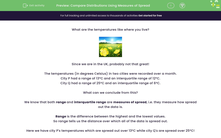What are the temperatures like where you live?

Since we are in the UK, probably not that great!
The temperatures (in degrees Celsius) in two cities were recorded over a month.
City P had a range of 13°C and an interquartile range of 12°C.
City Q had a range of 25°C and an interquartile range of 6°C.
What can we conclude from this?
We know that both range and interquartile range are measures of spread, i.e. they measure how spread out the data is.
Range is the difference between the highest and the lowest values.
So range tells us the distance over which all of the data is spread out.
Here we have city P's temperatures which are spread out over 13°C while city Q's are spread over 25°C!
What does that mean?

Well, for example city Q's lowest and highest temperatures in a month could be 0°C and 25°C.
City P's minimum and maximum temperature could be e.g. 14°C and 27°C.
(It's important to note that we have no way of knowing the minimum and maximum from the information given! We are just speculating to understand this better)
So we can see that the range being bigger in city Q tells us that it has some days which are much colder than its hottest day - to the point that they could be from two different seasons!

The temperatures in city Q therefore have more variability, i.e. how much temperatures vary.
On the other hand, interquartile range tells us the measure of spread of the middle 50% of the data (between the lower and upper quartile).
We know that city P has an interquartile range of 12°C while city Q has IQR of only 6°C.
This means that the middle 50% of the data is closer together in city Q than in city P, i.e. there is less variability in the middle 50% of the data in city Q.
So, while the range is much higher in city Q, indicating higher variability overall, the middle 50% of the data is less variable in city Q than in city P.
Putting that in the context of our temperatures, half of the days in city Q are around the same temperature (median, since IQR includes median) but then there are some much hotter and/or much colder days!
Whereas in city P the temperatures don't swing to either extreme as much, but the temperatures show a greater difference since the IQR is higher.
Don't worry if that sounds complicated right now - it will all become clearer as we go through the questions!







